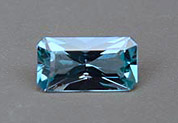



Blue to blue-green beryl, known as aquamarine, is quite a familiar stone, a staple in jewelry stores, catalogs and on home shopping programs, and rightly so. It is a magnificent gem which can be stunningly beautiful when well cut and polished and of good size and color. Unfortunately, huge amounts of material have been sold which either lack enough color to truly be called aquamarine or which are inferior in their fashioning. The most common natural color for this gem is a light to medium light slightly to moderately greenish blue. The name, aquamarine, then, indicates its resemblance to the color of sea water.
Virtually all rough is heated to convert some of the green tones to blue. The treatment is undetectable and stable and therefore the consumer should assume all pieces to be heated unless otherwise specified. Recently a growing number of consumers have begun to appreciate the natural greenish gems.
At hardness 7.5 it makes an acceptable ring stone and requires no special care or precautions in cleaning. The most common types of inclusions found in this variety are liquid filled fingerprints and hollow growth tubes. Major sources of stones include Brazil, Nigeria, Zambia and Madagascar. A common simulant for this gem is light blue synthetic spinel which can easily be distinguished from aqua by its optic character and refractive index. Aquamarine is the birthstone for March.




The deepest blue large stones have the highest value with medium and light blue stones of the same size fetching less. In smaller sizes, price still depends on color which is harder to obtain in small pieces. Blue-green stones of any size have traditionally had only about 50 -75% of the value of true blues, but this is changing as consumers are beginning to favor and seek out unenhanced stones. Mass production of blue topaz by irradiation in the 1980's briefly depressed the aqua market, but it rebounded when topaz took a nose-dive -- chiefly because the supply of darker blue topaz is virtually unlimited whereas only nature can make fine colored aquas which are now, and always have been, rare. Heating doesn't darken the color of aqua it just diminishes the green component. African aquamarine is relatively more abundant and can be less expensive that comparable Brazilian material.